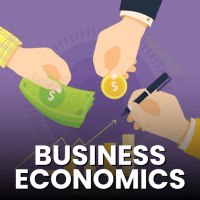CA Foundation Exam > CA Foundation Questions > Cost of living increases when business cycle ...
Start Learning for Free
Cost of living increases when business cycle is _____
- a)expanding
- b)contracting
- c)at peak
- d)at lowest point
Correct answer is option 'C'. Can you explain this answer?
Verified Answer
Cost of living increases when business cycle is _____a)expandingb)cont...
Cost of living typically increases when the business cycle is at peak. At this stage, economic activity is at its highest, leading to increased demand for goods and services, which can drive up prices. This results in inflationary pressures, causing the cost of living to rise. In contrast, during expansion phases, economic growth is more balanced with increasing employment and production, without immediate inflation.
Most Upvoted Answer
Cost of living increases when business cycle is _____a)expandingb)cont...
Understanding Cost of Living Increases in the Business Cycle
The business cycle consists of four main phases: expansion, peak, contraction, and trough. Cost of living increases are particularly prominent during the peak phase of the business cycle. Here’s a detailed breakdown of why this happens:
1. Economic Expansion
- During expansion, economic activity is rising, leading to increased employment and income levels.
- As more people earn higher wages, demand for goods and services increases, which can drive up prices, but this is not as pronounced as in the peak phase.
2. Economic Peak
- The peak phase signifies the height of economic activity.
- Businesses operate at full capacity, and the labor market is tight, resulting in wage increases.
- Increased demand and higher production costs combine to raise prices, leading to significant cost of living increases.
3. Contraction Phase
- In this phase, economic activity slows down.
- Demand decreases, and businesses may cut back on hiring or lay off workers, leading to stagnant or falling wages.
- Consequently, the cost of living tends to stabilize or even decrease, as companies lower prices to attract consumers.
4. Lowest Point (Trough)
- At the lowest point of the cycle, economic activity is at its minimum.
- High unemployment and reduced consumer spending lead to further decreases in prices, which can lower the cost of living.
Conclusion
In summary, the cost of living increases most significantly during the peak of the business cycle due to heightened economic activity, increased wages, and rising demand. Understanding these dynamics is crucial for analyzing economic trends and their impacts on daily life.
The business cycle consists of four main phases: expansion, peak, contraction, and trough. Cost of living increases are particularly prominent during the peak phase of the business cycle. Here’s a detailed breakdown of why this happens:
1. Economic Expansion
- During expansion, economic activity is rising, leading to increased employment and income levels.
- As more people earn higher wages, demand for goods and services increases, which can drive up prices, but this is not as pronounced as in the peak phase.
2. Economic Peak
- The peak phase signifies the height of economic activity.
- Businesses operate at full capacity, and the labor market is tight, resulting in wage increases.
- Increased demand and higher production costs combine to raise prices, leading to significant cost of living increases.
3. Contraction Phase
- In this phase, economic activity slows down.
- Demand decreases, and businesses may cut back on hiring or lay off workers, leading to stagnant or falling wages.
- Consequently, the cost of living tends to stabilize or even decrease, as companies lower prices to attract consumers.
4. Lowest Point (Trough)
- At the lowest point of the cycle, economic activity is at its minimum.
- High unemployment and reduced consumer spending lead to further decreases in prices, which can lower the cost of living.
Conclusion
In summary, the cost of living increases most significantly during the peak of the business cycle due to heightened economic activity, increased wages, and rising demand. Understanding these dynamics is crucial for analyzing economic trends and their impacts on daily life.

|
Explore Courses for CA Foundation exam
|

|
Question Description
Cost of living increases when business cycle is _____a)expandingb)contractingc)at peakd)at lowest pointCorrect answer is option 'C'. Can you explain this answer? for CA Foundation 2025 is part of CA Foundation preparation. The Question and answers have been prepared according to the CA Foundation exam syllabus. Information about Cost of living increases when business cycle is _____a)expandingb)contractingc)at peakd)at lowest pointCorrect answer is option 'C'. Can you explain this answer? covers all topics & solutions for CA Foundation 2025 Exam. Find important definitions, questions, meanings, examples, exercises and tests below for Cost of living increases when business cycle is _____a)expandingb)contractingc)at peakd)at lowest pointCorrect answer is option 'C'. Can you explain this answer?.
Cost of living increases when business cycle is _____a)expandingb)contractingc)at peakd)at lowest pointCorrect answer is option 'C'. Can you explain this answer? for CA Foundation 2025 is part of CA Foundation preparation. The Question and answers have been prepared according to the CA Foundation exam syllabus. Information about Cost of living increases when business cycle is _____a)expandingb)contractingc)at peakd)at lowest pointCorrect answer is option 'C'. Can you explain this answer? covers all topics & solutions for CA Foundation 2025 Exam. Find important definitions, questions, meanings, examples, exercises and tests below for Cost of living increases when business cycle is _____a)expandingb)contractingc)at peakd)at lowest pointCorrect answer is option 'C'. Can you explain this answer?.
Solutions for Cost of living increases when business cycle is _____a)expandingb)contractingc)at peakd)at lowest pointCorrect answer is option 'C'. Can you explain this answer? in English & in Hindi are available as part of our courses for CA Foundation.
Download more important topics, notes, lectures and mock test series for CA Foundation Exam by signing up for free.
Here you can find the meaning of Cost of living increases when business cycle is _____a)expandingb)contractingc)at peakd)at lowest pointCorrect answer is option 'C'. Can you explain this answer? defined & explained in the simplest way possible. Besides giving the explanation of
Cost of living increases when business cycle is _____a)expandingb)contractingc)at peakd)at lowest pointCorrect answer is option 'C'. Can you explain this answer?, a detailed solution for Cost of living increases when business cycle is _____a)expandingb)contractingc)at peakd)at lowest pointCorrect answer is option 'C'. Can you explain this answer? has been provided alongside types of Cost of living increases when business cycle is _____a)expandingb)contractingc)at peakd)at lowest pointCorrect answer is option 'C'. Can you explain this answer? theory, EduRev gives you an
ample number of questions to practice Cost of living increases when business cycle is _____a)expandingb)contractingc)at peakd)at lowest pointCorrect answer is option 'C'. Can you explain this answer? tests, examples and also practice CA Foundation tests.

|
Explore Courses for CA Foundation exam
|

|
Signup for Free!
Signup to see your scores go up within 7 days! Learn & Practice with 1000+ FREE Notes, Videos & Tests.


















